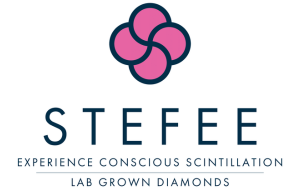Even though lab-grown diamonds are created in laboratories by experts, they may have imperfections like natural diamonds. These blemishes or inclusions significantly impact a lab-grown diamond's clarity and sparkle. Eventually, it also influences the gemstone's grading and prices. In order to make the best investment, you need to understand how clarity affects synthetic diamonds' appearance and value.
In this guide, we will cover everything you need to know about diamond clarity in a lab-grown diamond.
What is Lab-Grown Diamond Clarity?
Diamond clarity means the number of inclusions, flaws, or blemishes in a lab-grown diamond stone. These imperfections create contrasting areas of brightness and darkness within a diamond. While these flaws affect its brilliance and market value, they are not visible to the naked eye.
The lab-grown diamond clarity is evaluated with the help of specialised tools by the two leading grading labs, IGI and GIA. Lab-created diamonds at Stefee Jewels are GIA-certified.
What Causes Imperfections in Lab-Grown Diamonds?
The following factors are responsible for a lab-grown diamond's clarity:
-
Growth Method: Lab-grown diamonds are produced using HTHP (high pressure, high temperature) and CVD (chemical vapour deposition) methods. The HTHP method can cause inclusions from metallic particles and graphite getting trapped during the process. The CVD process can cause inclusions such as small crystals, clouds, and growth lines due to gas composition and temperature variations.
-
Contamination: Contaminants from the growth chamber, equipment, or handling can become incorporated into the diamond, resulting in inclusions.
- Post-Growth: Post-growth treatments such as laser drilling and fracture filling can introduce new or modify existing blemishes. These treatments aim to improve appearance but can leave traces, impacting the diamond's clarity.
The Lab-Grown Diamond Clarity Scale
Diamonds, whether natural or lab-created, are graded for clarity using a standardised scale by the IGI and GIA. A clarity grading is determined by examining the lab-grown diamond under a 10x magnification loupe.
The evaluation process involves counting the number of inclusions, their size and location while assigning a clarity grade.
The lab-grown diamond clarity chart is as follows:
-
Flawless (FL): FL-graded lab-grown diamonds are flawless, extremely rare and valuable. No inclusions or blemishes are visible in these diamonds, even under 10x magnification.
-
Internally Flawless (IF): In IF-graded lab diamonds, no inclusions are visible to the naked eye. However, minor blemishes may be visible on the surface of the diamond when checked under 10x magnification.
-
Very Very Slightly Included 1 (VVS1): In VVS1-graded lab-grown diamonds, it is very difficult to see inclusions under 10x magnification, even for the trained and experienced eyes.
-
Very Very Slightly Included 2 (VVS2): Inclusions are barely visible in VVS2 lab diamonds. However, VVS2 diamonds have slightly more blemishes than VVS1.
-
Very Slightly Included (VS1): VS1-graded lab diamonds have minor inclusions that are visible only under 10x magnification but are difficult to find.
-
Very Slightly Included (VS2): The inclusions of a VS2 lab-grown diamond are easily noticeable under a 10x magnification but difficult to spot with the naked eye.
-
Slightly Included 1 (SI1): Varying on the diamond cut and shape, SI1 diamond inclusions are easily visible under magnification as well as to the naked eye.
-
Slightly Included 2 (SI2): Inclusions are clean to be easily observable under magnification or to an untrained eye.
- Included (I1, I2, I3): I1, I2, and I3 clarity inclusions are easily spotted as they are significant in size and number. They can be found with or without magnification, even in step-cut diamonds like emerald or Asscher-shaped lab-grown diamonds India.
Types of Lab-Grown Diamond Inclusions
-
Crystal: A crystal inclusion occurs during diamond formation, where mineral deposits or tiny diamond pieces get trapped inside the diamonds. This inclusion gives an illusion of a diamond inside a diamond.
-
Needle: A needle inclusion is similar to a sewing needle, as it looks like a long, thin silver line.
-
Pinpoints: Pinpoints look like tiny black spots or specks within the lab-grown diamond.
-
Feathers: A feather is similar to the needle inclusion in shape but has tiny cracks from top to bottom. These internal fractures appear like feathers under magnification.
-
Cloud: The cloud inclusion is a group of tiny inclusions that resemble a cloud, giving the diamond a hazy or milky appearance.
-
Knot: This inclusion includes several tiny crystal pieces that create a bump or raised area on the diamond's surface.
-
Cavity or Chip: A cavity or gap usually forms at a weak point of the diamond's surface during cutting.
-
Graining: Graining inclusions appear like internal scratches, lines or streaks similar to a wood grain.
- Twinning Wisp: These are irregular and intertwined inclusions formed during manufacturing. It is a mix of pinpoints, needles, feathers and clouds.
What Lab-Grown Diamond Clarity Grade Should You Choose?
One must always go for an FL or IF-grade lab-grown diamond, as they are free from inclusions. However, if you have budget constraints, you can go for VSI-VS2 or SI1-SI2 lab diamonds as well.
